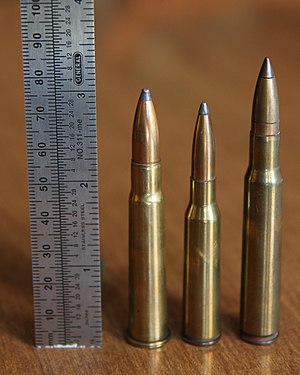6.5×50mmSR Arisaka
| 6.5×50 Arisaka | ||||||||
|---|---|---|---|---|---|---|---|---|

6.5×50mmSR Arisaka (center) with .303 British (left) and .30-06 (right).
|
||||||||
| Type | Rifle | |||||||
| Place of origin | Japan | |||||||
| Service history | ||||||||
| Used by | Japan, Russia, United Kingdom, China, North Korea, South Korea, Thailand, Finland, Indonesia, Cambodia, Poland | |||||||
| Wars | Russo-Japanese War, World War I, Second Sino-Japanese War, World War II, Indonesian War of Independence, Korean War, Malayan Emergency | |||||||
| Production history | ||||||||
| Produced | 1897–1945 | |||||||
| Specifications | ||||||||
| Case type | Semi-rimmed, bottlenecked | |||||||
| Bullet diameter | 6.705 mm (0.2640 in) | |||||||
| Neck diameter | 7.34 mm (0.289 in) | |||||||
| Shoulder diameter | 10.59 mm (0.417 in) | |||||||
| Base diameter | 11.35 mm (0.447 in) | |||||||
| Rim diameter | 11.84 mm (0.466 in) | |||||||
| Rim thickness | 1.143 mm (0.0450 in) | |||||||
| Case length | 50.39 mm (1.984 in) | |||||||
| Overall length | 75.69 mm (2.980 in) | |||||||
| Rifling twist | 1/9 inches | |||||||
| Primer type | Large rifle | |||||||
| Ballistic performance | ||||||||
|
||||||||
| Test barrel length: 800 mm | ||||||||
The 6.5×50mm Semi-Rimmed (6.5×50mmSR) Japanese cartridge, currently manufactured under the designation 6.5mm Jap, was adopted by the Imperial Japanese Army in 1897, along with the Type 30 Arisaka infantry rifle and carbine. The new rifle and cartridge replaced the 8×52mm Murata round used in the Type 22 Murata Rifle. In 1902 the Imperial Japanese Navy chambered its Type 35 rifle for the cartridge as well. In 1905, the round also came to be offered in the Type 38 Arisaka infantry rifle and carbine, both of which rendered the Type 30 obsolete in Imperial Army service. Type 44 cavalry carbines, first adopted in 1911, were also chambered in 6.5×50mm.
Early 6.5×50mm cartridges had a cupronickel, round-nosed bullet weighing 10.4 grams (160 gr) fired with approximately 2.0 grams (31 gr) of smokeless powder. This was later changed with the adoption of the Type 38 when Japan, in line with the other great powers around the same time, changed to the pointed or spitzer bullet in the first decade of the twentieth century. The Type 38 spitzer-bullet round fired a 9.0-gram (139 gr) bullet with a powder charge of 33 grains (2.1 g) for a muzzle velocity of around 770 metres per second (2,500 ft/s).
The round was criticized for being underpowered compared to other, more powerful American and European cartridges such as the .30-06, .303 British, 7.92×57mm Mauser, and 7.62×54mmR. For this reason it was later replaced by the more powerful 7.7×58mm cartridge.
The Type 38 spitzer version of the 6.5×50mm cartridge remained unchanged until after the adoption of the Type 11 light machine gun in 1922. The Type 11 was initially meant to fire standard Type 38 rifle ball ammunition by means of ordinary five-shot Type 38 stripper clips. Subsequent use indicated that the higher pressures generated by the standard rifle ammunition caused parts wear and breakage in machine guns. It was thus decided to reduce the powder charge of the Type 11's 6.5 mm ammunition to overcome the problem. This reduced charge 6.5 mm ammunition can be identified by a letter "G" in a circle stamped on the outside of the ammunition packaging which stands for the first letter of genso - the Japanese word for "reduced." This special ammunition was also issued to soldiers carrying the Type 96 light machine gun introduced in 1936 and to snipers issued the Type 97 sniper rifle, introduced in 1937. The advantage of the reduced charge ammunition to the sniper was it aided in his concealment as the reduced charge rounds produced less muzzle flash than standard rounds and thus did not give away the sniper's position.
...
Wikipedia
